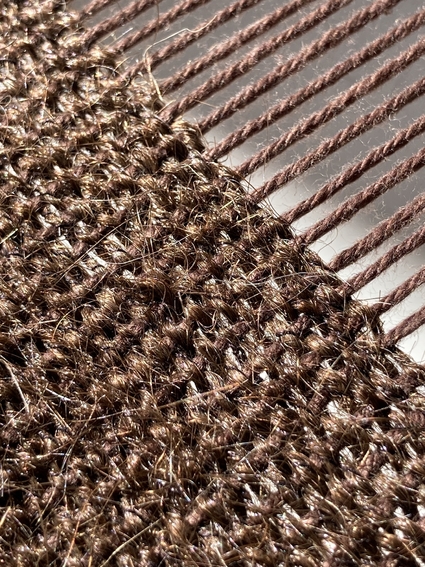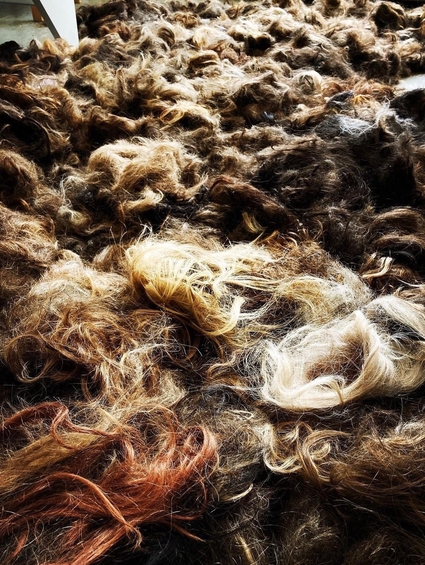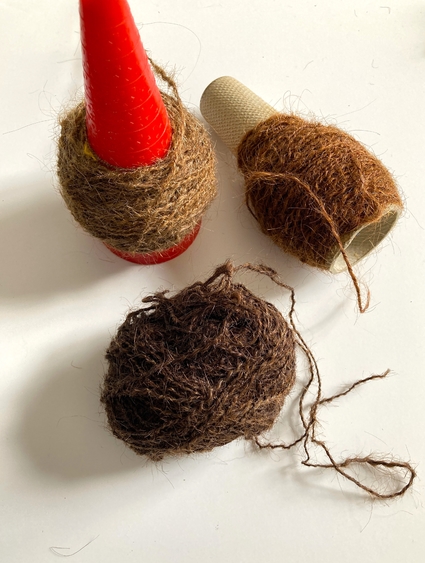Project Description
During the multiple lockdowns of the Covid-19 pandemic, access to hair salons and barbers was greatly limited in the Netherlands. I became aware that friends and neighbours felt a desperation for a cut as soon as the salons were able to reopen. Life had slowed, warped and shifted into one shared through a computer screen, rather than a physical space of interaction. For many this involved a different and intense confrontation with self-image, the passing of time, and curtailed personal freedoms.
As lockdown rules lifted, longer than average lengths of locks were being shed, and the busy days of cutting by fully booked salons produced large piles of hair waste. The intimate fibre suddenly seemed loaded with the stresses and anxieties of the pandemic, caught in the cells of its structure. I began collecting hair from various salons around Amsterdam, often in bin bags mixed with face masks and hair product packaging. I continued collecting hair for two months, storing the bags of waste material safely, and kept waiting. I now plan to spin the hair fibre into yarn using a traditional wooden spinning wheel. The hair yarn, a mix of identities, nationalities, ages and colours, will then be woven into a large wall tapestry as a form of commemorative and collaborative portrait of our times.
Tapestries have historically been woven to record and celebrate historic events, and the utilisation of this form seems a fitting marker or keeper of the pandemic, drawing and interweaving us together once more. It can be seen as both a blanket and a barrier. The DNA of anxiety and intertwined identities will be spun together reconnecting a community that has been kept apart and in isolation in unprecedented ways within our lifetime.
During my early career as an artist I worked primarily with human hair as both medium and reference, to create works which have been shown internationally within prominent exhibitions. A series of ‘impossible’ dresses and sculptural forms of distorted proportions, including Dress, Depilator and Sibilla, were constructed from knitted human during the 1990’s, following my graduation from Glasgow School of Art. Exhibitions of this work include Revelation at the Barbican Centre and National Museum of Modern Art Kyoto, 1997; Addressing the Century: 100 Years of Art and Fashion, at Hayward Gallery London, and Kunstmuseum, Wolfsburg, 1998; Weaving the World, at Yokohama Museum of Art, 1999; and Body Extensions in MUDAC, Lausanne, 2004.
Since moving to the Netherlands in 1997, I have changed my focus and practice in terms of process and material. My interest and research into ritual and embedded narratives has continued, but was made more visible through photography and audio techniques. During the pandemic I became intrigued once more with hair as a container and emblem, as well as the rhythmic and ritual like repetitive processes involved in cutting, spinning and weaving. A return to simple meditative actions and repurposing of materials that are in greater harmony with the current times of restricted travel and respect to nature seems fitting, whilst still related to my research and recent field work in Japan and South Korea.
Possible ways to expand the project
A series of structures based on Japanese sliding screens and room dividers will be developed. These act as both the weaving frame for further hair tapestries, as well as the exhibition frame, offering works of a more sculptural dimension that is functional beyond the initial and formal wall tapestry.
The recent protests and civil unrest in Iran in response to the death of 22 year old Mahsa Amini, after allegedly wearing her hijab 'improperly', have raised prominent references and thoughts for new works. Protests have spread extensively, predominantly by women, with the defiant removal of the hijab, and the cutting of their hair. A series of silk scarves with the screen printed image of hair in a decorative braid, an early work from my archive made in 1993, will be remade in response and support of the protests by the women risking their lives.
Personal introduction
Emily Bates is an artist and photographer based in Amsterdam. Her work explores landscape narratives, rituals and nature’s rhythms.
She was invited to create the video animation Lost Spring. Lost Year, for the inaugural video commission on the facades of the newly renovated Museum W in Weert, Limburg, which opened in the Spring of 2022.
Her photographic work, The sky is glowing with the setting sun, made in Japanese islands rich in shamanistic heritage and dense subtropical forests, can currently be seen within the group exhibition Face-à-Face at MUDAM Musée d’Art Moderne Grand-Duc Jean, Luxembourg. The exhibition is a conversation between the collection of Mudam and Saarlands Museum in Saarbrücken, and includes works by de Chirico, Ernst, Leger, Matisse, Moholy-Nagy, Renoir, Rodin, Katinka Bock, Nan Goldin, Alicja Kwade, and Lee Bul, amongst others.
Estimated costs
In order to weave the tapestry, funding is required for the construction of a large wall loom, warp thread as a base structure, additional space in which to spin the hair, and time. Spinning equipment is already available.
Estimated costs:
Materials and tools: €800
Studio rent: € 1000
Time and assistance: € 4000
This proposal is part of the 'Penny for your Thoughts' project 2022.


